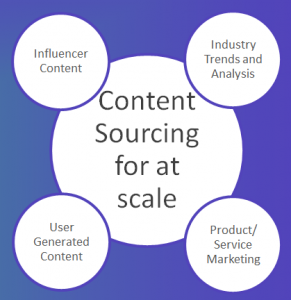Creating Scale: Supporting Evolving Needs
Register now for the upcoming
Press Pause for Sales Enablement webinar.
67% of B2B buyers rely more on content research today than last year to make decisions.
— Demand Gen 2016 Content Preferences Report
“Scaling” focuses on a capacity model that supports the changing needs of your business and its customers. This includes:
- Content
- Metrics
- Analytics Alignment
- Automation Systems & Tools
Let’s explore this in more detail.
Content
 Content needs to be organized and structured for easy re-use by sales and marketing. It is important to understand the lifecycle of the customer and where content for each stage within it fits into the equation. Identify content overlap (e.g. product key-selling points) so both sales and marketing can collaborate effectively. Also, measure the collaborative content across both teams – this will assist in resource allocation and reduce duplication of effort.
Content needs to be organized and structured for easy re-use by sales and marketing. It is important to understand the lifecycle of the customer and where content for each stage within it fits into the equation. Identify content overlap (e.g. product key-selling points) so both sales and marketing can collaborate effectively. Also, measure the collaborative content across both teams – this will assist in resource allocation and reduce duplication of effort.
Consistent use of language (labels and definitions) helps to reduce confusion and keeps teams aligned. The system architecture (content management system, web content management system, etc.) should support componentized content that can scale. Incorporate the necessary data structures to deliver content across programs, channels and devices. Content should be structured and labeled so that it can be (re)assembled to suit multiple purposes and accommodate for metrics gathering. You can build a solid approach with the following steps:
- First, define what content is necessary for initial and ongoing sales enablement, using the customer journey to identify gaps and needs.
- Next, put in place the necessary resources to create, source and publish the content. Make sure you account for current and future content needs.
- Finally, to create a consistent brand story, craft content lifecycles around customer needs that align among all business units.
A content plan and editorial strategy are crucial to a successful effort.
Metrics
Metrics are an essential piece of a sales enablement content strategy. Create a metrics model with clear objectives that center on the customer lifecycle. Then, look at where data needs to be collected to support those measurements. Consider the following areas:
- Buyer Engagement
- Sales Readiness
- Cross-channel Touchpoints
Both quantitative and qualitative measures are useful, depending on context and the identified objectives. Each team (sales, marketing, digital, customer sales reps, etc.) should be evaluated on sales readiness and how they push the customer from one stage of the customer lifecycle to the next. Do not rely simply on metrics within internal teams, cross-channel engagement metrics demonstrate the ability to interact with the customer at multiple points. Make sure you understand what the customer does within each channel, but also what they do when they move from one channel to the next.
Analytics Alignment
Organizations often have multiple teams gathering metrics and providing subsequent analysis. This can create an “apples to oranges” situation where business units are drawing conclusions based on varying metrics. To alleviate this situation:
- Build consensus between your teams on your metrics model and associated objectives.
- Confirm that quantitative data (web metrics, sales data, etc.) is consistent – using the same methodology, data definitions, and preferably the same statistics platform.
- Agree on qualitative data-gathering techniques: i.e., customer insights, behavioral, etc.).
- Ensure analytics teams have the agreed-upon objectives in place to measure, and build dashboards based on the overarching metrics strategy.
A robust analytics approach accounts for a reporting mechanism, such as dashboards and regularly appearing reports. Make sure you report out to all of the necessary stakeholders and business units.
Automation Systems & Tools
Platforms are meaningless in the absence of an enterprise content strategy.
An enterprise or sales enablement content strategy should inform the technical infrastructure – not the other way around. Automation for enterprise content strategy requires a unified approach.
But how do you ensure you have that effective strategy in place? Whether you are building one, validating one or reverse engineering one, here are the steps:
- Get stakeholders to agree on an enterprise-wide approach to content.
- Map content to the entire customer lifecycle, including pre- to post-sales.
- Agree on the best way for teams to collaborate to deliver strategy together.
- Enact a step strategy to move towards sales enablement content maturity.
- Source content from across business units and organize for re-use.
A customer-centric publishing model starts with the needs of the customer and works backwards to develop a publishing model. This approach is silo-agnostic and more adaptive to changes in user and technology trends. Leveraging the lifecycle to inform a tech stack allows sales teams to:
- View technology needs contextually
- Understand the customer journey(s) prior to an organization’s technology purchase or implementation
- Eliminates unnecessary functionality
- Develop a customer-centric publishing model and focus on user targets
- Drive content experiences across all distribution channels
- Align content and messaging
Keeping the customers’ needs in mind during all aspects of content creation, publishing, analytics development, and technology implementation will help organizations to scale their content operations, as well as increase customer engagement and conversion.
